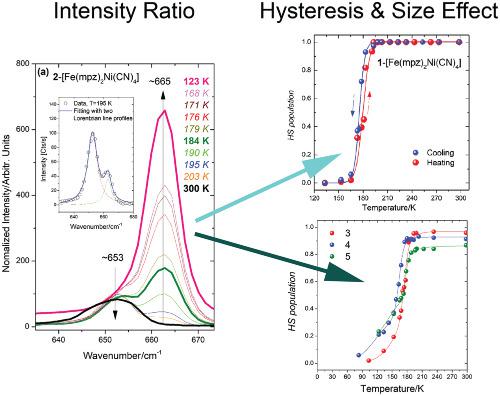当前位置:
X-MOL 学术
›
J. Raman Spectrosc.
›
论文详情
Our official English website, www.x-mol.net, welcomes your
feedback! (Note: you will need to create a separate account there.)
Monitoring the spin crossover phenomenon of [Fe(2‐mpz)2Ni(CN)4] 2D Hofmann‐type polymer nanoparticles via temperature‐dependent Raman spectroscopy
Journal of Raman Spectroscopy ( IF 2.4 ) Pub Date : 2020-08-17 , DOI: 10.1002/jrs.5967 Zoi G. Lada 1 , Konstantinos S. Andrikopoulos 1 , Christina D. Polyzou 2 , Vassilis Tangoulis 2 , George A. Voyiatzis 1
Journal of Raman Spectroscopy ( IF 2.4 ) Pub Date : 2020-08-17 , DOI: 10.1002/jrs.5967 Zoi G. Lada 1 , Konstantinos S. Andrikopoulos 1 , Christina D. Polyzou 2 , Vassilis Tangoulis 2 , George A. Voyiatzis 1
Affiliation

|
The incorporation of spin crossover (SCO) properties into metal–organic frameworks (MOFs) has led to an appealing subclass of multifunctional MOFs. Because temperature is the most common way to manipulate the SCO phenomenon, the spin state of relevant complexes is conveniently monitored by variable‐temperature magnetic susceptibility (χMT) measurements. Other physical and spectroscopic techniques may also monitor the SCO behavior. In this context, the present work focuses on the use of variable‐temperature micro‐Raman spectroscopy. More specifically, the SCO behavior of the two‐dimensional Hofmann‐type MOF [FeII(2‐mpz)2Ni(CN)4], (2‐mpz = 2‐methylpyrazine), in the form of both bulk microcrystalline powder and nanoparticles is in depth analyzed via temperature‐dependent Raman spectroscopy. Magnetic susceptibility measurements were used in order to benchmark the vibrational spectroscopic ones. A brief introduction on the basic synthetic features of the samples and the morphological characteristics of representative samples are described, while the detailed syntheses of the MOF compounds in the microscale and the nanoscale were recently comprehensively addressed. It is unambiguously revealed for the samples in the different particle sizes that the SCO characteristics, such as Tc values, hysteretic behavior, and high spin (HS) population curves as a function of temperature, derived from Raman measurements are in close comparison with those of the magnetic susceptibility. In addition, spectroscopic analysis in the high‐ and low‐wavenumber regions suggests the 2D network structure of the specific compound and reveals the alterations at molecular level associated with the HS and low spin (LS) states. The significance of Raman spectroscopy for the study of SCO materials is demonstrated, because the technique offers combined structural characterization and detailed study of the transition.
中文翻译:

通过温度依赖性拉曼光谱监测[Fe(2-mpz)2Ni(CN)4] 2D霍夫曼型聚合物纳米粒子的自旋交叉现象
将自旋交联(SCO)属性合并到金属有机框架(MOF)中导致了多功能MOF的吸引人的子类。因为温度是操纵SCO现象最常见的方式,相关的复合物的自旋状态方便地通过变温磁化率(监测χ中号Ť)测量。其他物理和光谱技术也可以监视SCO行为。在这种情况下,本工作着重于可变温度显微拉曼光谱的使用。更具体地说,二维霍夫曼型MOF的SCO行为[Fe II(2-mpz)2 Ni(CN)4],(2-mpz = 2-甲基吡嗪),以块状微晶粉末和纳米颗粒的形式通过温度依赖性拉曼光谱进行深度分析。为了对振动光谱进行基准测量,使用了磁化率测量。简要介绍了样品的基本合成特征和代表性样品的形态特征,同时最近全面论述了MOF化合物在微观和纳米尺度上的详细合成。对于不同粒径的样品,SCO特性(如T c从拉曼测量得出的磁导率值,磁滞行为和高自旋(HS)总体曲线随温度的变化与磁化率的测量结果有着密切的比较。此外,在高波数和低波数区域的光谱分析表明了特定化合物的2D网络结构,并揭示了与HS和低自旋(LS)状态相关的分子水平的变化。证明了拉曼光谱学对SCO材料的研究意义,因为该技术提供了结合的结构表征和详细的过渡研究。
更新日期:2020-08-17
中文翻译:

通过温度依赖性拉曼光谱监测[Fe(2-mpz)2Ni(CN)4] 2D霍夫曼型聚合物纳米粒子的自旋交叉现象
将自旋交联(SCO)属性合并到金属有机框架(MOF)中导致了多功能MOF的吸引人的子类。因为温度是操纵SCO现象最常见的方式,相关的复合物的自旋状态方便地通过变温磁化率(监测χ中号Ť)测量。其他物理和光谱技术也可以监视SCO行为。在这种情况下,本工作着重于可变温度显微拉曼光谱的使用。更具体地说,二维霍夫曼型MOF的SCO行为[Fe II(2-mpz)2 Ni(CN)4],(2-mpz = 2-甲基吡嗪),以块状微晶粉末和纳米颗粒的形式通过温度依赖性拉曼光谱进行深度分析。为了对振动光谱进行基准测量,使用了磁化率测量。简要介绍了样品的基本合成特征和代表性样品的形态特征,同时最近全面论述了MOF化合物在微观和纳米尺度上的详细合成。对于不同粒径的样品,SCO特性(如T c从拉曼测量得出的磁导率值,磁滞行为和高自旋(HS)总体曲线随温度的变化与磁化率的测量结果有着密切的比较。此外,在高波数和低波数区域的光谱分析表明了特定化合物的2D网络结构,并揭示了与HS和低自旋(LS)状态相关的分子水平的变化。证明了拉曼光谱学对SCO材料的研究意义,因为该技术提供了结合的结构表征和详细的过渡研究。









































 京公网安备 11010802027423号
京公网安备 11010802027423号